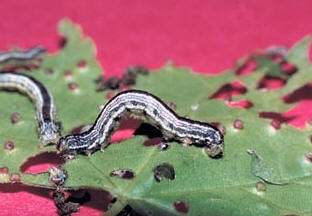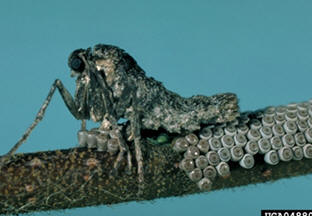Cankerworm
 DESCRIPTION
DESCRIPTION
Cankerworms have been documented as native North American tree pests since colonial days. Spring and fall cankerworm are similar in distribution, appearance and the damage caused. The fall cankerworm lays its eggs in the late fall and the spring cankerworm in late February or March. Both have a wide range of hosts that include deciduous shade and fruit trees. Apple and Elm seem to be preferred, but many Oaks, Maples, Hickories, Ashes and Beech are also fed upon
LIFE CYCLE
The fall Cankerworm lays about 100 eggs in an aligned, compact reddish-brown mass which becomes gray as it weathers. The eggs of both species hatch in the spring and the larvae feed on expanding buds and foliage. Feeding lasts 4 to 6 weeks and is apparent by the shothole appearance on the host plants leaves. Older larvae consume all of the leaf except for the major veins. Mature fall cankerworm larvae vary from light to dark green and are about 1 in long. Mature spring cankerworm larvae are 0.8 to 1.3 inches long and vary considerably in color, ranging from reddish to yellowish brown, yellowish green or black. The head is light and mottled with a yellowish stripe along each side of the body. Some older fall cankerworm larvae have a dark stripe running down the back and light green larvae have white lines running lengthwise. When the larvae finish feeding in early July and are ready to pupate, they crawl or spin down on silken threads to the ground and prepare cocoons in the soil. Fall cankerworm adults emerge in November or December and spring cankerworm adults emerge in February or March.
 DAMAGE
DAMAGE
Small holes in the new leaves are often the first sign of damage. As the cankerworm larvae eats, the holes become larger until only the leaf veins remain. During high populations, cankerworms can completely strip trees. Most trees grow back their leaves by early July. However, their growth is slower and they are less able to fight disease and other insect attacks.
CONTROL
A tree is normally very tolerant of some defoliation and control efforts are unnecessary when only a few larval cankerworms are present. However, at times when the cankerworm populations are high, it may be necessary to control them with the use of biological products or pesticides. Environmentally friendly products can be used to control outbreaks with the active ingredient of these products being Bacillus thuringiensis. Once the cankerworms are hanging on their silken threads, control is only possible with a pesticide. Whenever you use a pesticide, always follow label directions.


